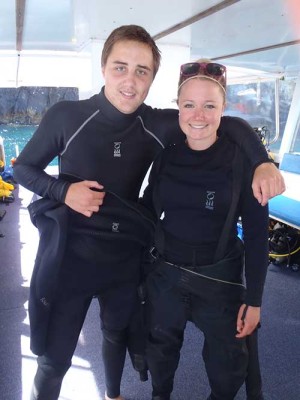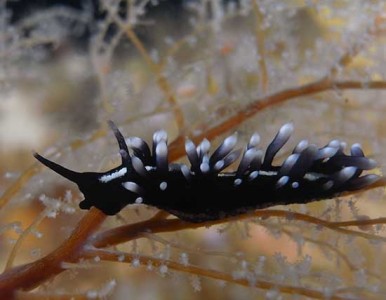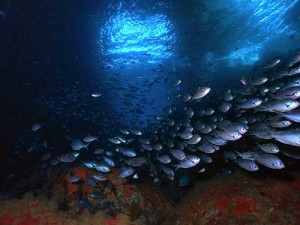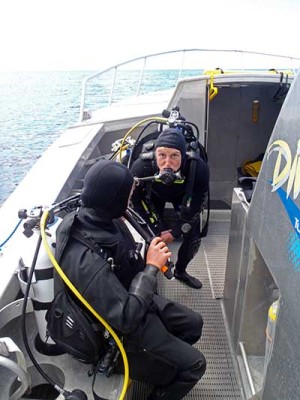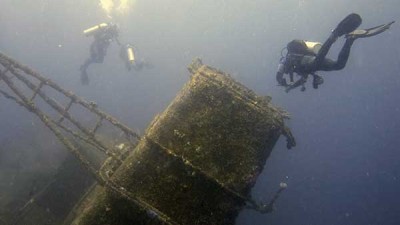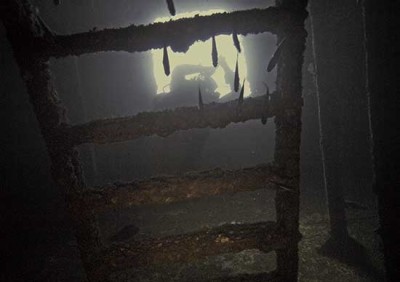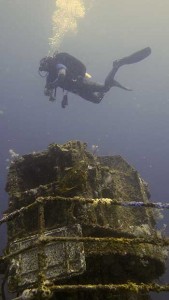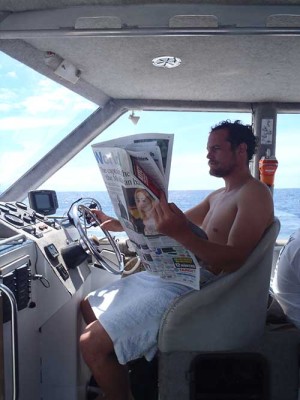The Poor Knights Islands have been classified as a marine reserve since 1981, with a complete ban on all recreational fishing coming into effect in 1998. It is a unique and flourishing environment – a special place to dive. A weekend spent diving in the Poor Knights with Pete Mesley as part of my Evolution+ CCR course made me eager to see more of this stunning marine reserve. I had spent the vast majority of my CCR course focused on skills, theory and not flooring it on the boat as I traipsed around with 30kg+ strapped to my back, so I was only just beginning to take in the impressive underwater scenes of the Poor Knights when the course came to an end.
Photo: Laurnet BernardThanks to Dive! Tutukaka dive centre I was able to spend an extra week exploring the Poor Knights. With a total of 5 boats and shelves stacked with awards, this dive centre has certainly made its mark on New Zealand and indeed the worldwide dive industry. Kate Malcolm and Jeroen Jongejans have created a dive centre that makes diving the Poor Knights a memorable and fun experience. With a crew of carefully selected individuals the busy dive days are planned and executed with fluidity and a personal touch. What’s more, diving here is a sustainable and diverse affair. Kate and Jeroen ensure there is a big focus on the importance of the marine reserve status and they have created awesome artificial wreck sites in the from of ex-naval ships. Dive! Tutukaka is an impressive dive centre.
As a temperate environment the Poor Knights is swathed in kelp fronds and an array of fish species. With the East Auckland Current (EAC) channeling down all the way from the Coral Sea there is a subtle tropical influence to diving here. The water temperature may attest this, but you do find subtropical species such as the black grouper hiding out amongst its more befitting temperate fish mates. In addition to the influence of the EAC, the rocky subtidal topography, clear water and marine reserve status combine to produce a remarkable biological assemblage. Dolphins, orcas, manta rays and bronze whaler sharks are even known to cruise around the islands. Although I didn’t spot any of these t-shirt worthy species, there was certainly a multitude of other interesting sights to keep me amused.
Photo: Laurent BernardThe rocky walls and staircases were laden with anemones, nudibranchs, urchins, sponges – and of course kelp. Chromis were to be found everywhere, restlessly and continuously defending their brood of eggs, while the stingrays were a tad more inconspicuous and hid out amongst the kelp fronds or silently flew over the reef. Not only is the variety of life at the Poor Knights impressive, there are also caves and arches spattered around the islands and these make for a really interesting change to the reef dives. Blue Mao Mao arch made for one of my best dives in the Poor Knights: the light funneled through the arch just enough to create a soft blue hue, silhouetting the divers as they swam through. Schools of fish were hiding out in the dark recesses while mini blennies darted about the boulders on the bottom. Although the arch was not filled with its namesake of maomao on this day, there was a horde of other fish to be found shrouding themselves in the darkness.
Photo: Laurent BernardThe reefs, walls, caves and arches of the Poor Knights Islands make for some of the worlds best dive sites. Even Jacque Cousteau himself said so. But the ultimate dive during my stay turned out to be a wreck dive. The frigate ex HMNZS Waikato was purposely sunk along the Tutukaka coastline in 2000, creating a new playground for divers. The 113m long ship served in the Royal New Zealand Navy from 1966-1998 and today it lies in 30m of water with the imposing turret and one propeller intact. As I followed my guide Steve Helmstalk along the side of the ship – which lies at an angle in the sand and as such a diver can quite easily feel disorientated – we came to the split.
The ship has split clean in two, the bow section lying approximately 15m away from the rest of the ship. As I turned with my back to the bow I looked upon the 5 slanted decks of the rest of the ship. I can best describe this as looking like a doll’s house: the 5 decks are each divided into neat little rooms stacked one above the other. I can’t recall ever seeing such a clean split in a wreck and with the decks layed out as they are it is an invitation to play.
There are plenty of safe and light filled penetrations on the Waikato so Steve and I took our time exploring the best this wreck had to offer. Despite the Waikato being a relatively new wreck it is covered in life. Anemones and nuibranch can be found throughout and the fish are either buzzing around the outside or dwelling in the darkness of the inside. As we entered the communications room we found Crayfish had tidied themselves away by taking up residence in the slotted shelves.
Exploring the Waikato was quite simply fun. There are so many corridors to explore and rooms to peek into. Each room is filled with its own collection of marine life and the new residents all looked quite at home nestled amongst the ships original features. Entering the ship from the port side from a depth of about 20m we were drawn through the decks, making our way through the shaded corridors and abandoned rooms. As we emerged from the bottom deck on the starboard side we swam out onto the sandy seafloor at 30m. I turned and looked up to see the mass of the ship towering over me.
The ascent was an opportunity to take in more of the features adorning the outside of the wreck. Much of it is intact with railings still running the length of the ship and the turret prominently protruding from the deck. Even for the more novice diver, or those uninterested in taking a look inside, there is enough to keep a diver amused for hours on the outside. I could quite happily of spent many days exploring the Waikato.
Spending an extra week diving in and around the Poor Knights Islands with Dive! Tutukaka turned out to be a great decision. As the scholarship year has progressed I have become interested in exploring the more temperate-cold water regions of the world and the Poor Knights ranks highly in this category. Even those divers who are usually to be found dwelling in tropical waters would surface from their dives here with a new found appreciation for colder water and the novelties it brings.


